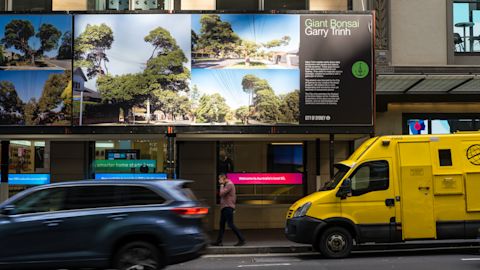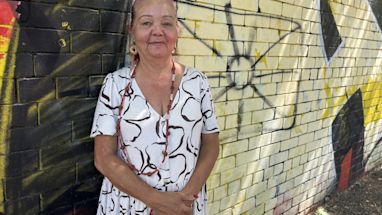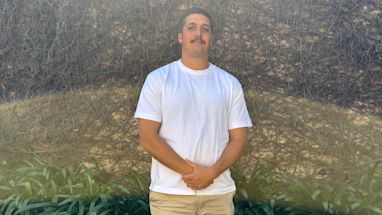Australian artists have been getting creative with our city’s construction sites since 2016, turning dull hoardings into fabulous artworks.
We spoke to a few artists about what it’s like to see their work on a construction site.
Suspended Figures by Prudence Stent and Honey Long
Suspended Figures is a series of fluid shapes created by bodies, fabric and wind. The photographs were taken over several years and are usually displayed as individual artworks. This is the first time the shapes have been combined.


“We hope our work provides an interesting break in the cityscape and sparks people’s thoughts and feelings about their own bodily experiences,” artists Prudence Stent and Honey Long said.
The artists said the creative hoardings program has been a great opportunity to reach a wider audience and display artwork outside the gallery context.
“It’s also been fun seeing our works produced on such a large scale!”
Magic Circles by Kieran Butler


Magic Circles is a dedication of love and devotion to the LGBTIQ communities.
“I want people to feel visible when they see my work, even if it’s just for a second,” artist Kieran Butler said.
“I hope it also makes spaces that are often typically very macho feel a little more welcoming.”
Kieran said they loved that construction sites are transformed into something engaging for the public.
“Someone emailed me directly to let me know that my work had made them feel seen while passing one of the hoardings. This helped them to express their truth to the friend they were with. It’s probably the most validating piece of feedback for me to receive as an artist.”
Midnight Zoo by Studio A


Social enterprise Studio A tackles the barriers that artists living with intellectual disability face. The Sydney-based studio supports artists to access professional development pathways to achieve their creative aspirations. Midnight Zoo is a collaboration by 4 Studio A artists.
“People can see the animals like they’re at the zoo. There's an elephant, giraffe, zebra, swan and a bear. Maybe the animals are dancing in the zoo!” artsit Emily Crockford said. Emily was the recipient of the Australia Council's prestigious National Arts and Disability Award for an Emerging Artist.
“The fact my art is out in the community, adds a different feel to the neighbourhood and streets. My family was proud of me, seeing my work outside the studio. My partner thinks we need to see more of it, to liven up the city a bit!” artist Phillip Sidney said.
Giant Bonsai by Gary Trinh


Sydney-based artist Gary Trinh’s work shows the magic in the mundane. The collection of giant bonsai were photographed all over Sydney.
“When I see the trees, I inevitably think about climate change and our partnership with nature. In a construction context these thoughts get magnified,” said Gary.
“What excites me is the opportunity to show work outside of a white cube, in a public space, to an audience other than an art-educated one.”
In the future… I want to be a unicorn by Alphabet Studio and students from Crown Street Public School


What do you get when you ask a group of 5 and 6 year olds to share their future aspirations? An overwhelmingly honest, whimsical and funny piece of art.
Local design collective, Alphabet Studio, worked on this project with students at Crown Street Primary in Surry Hills.
Asked what they want to be in the future, the young artists said:
“… a superhero
“… a scientist so I can do experiments
“… a power ranger
“… a lion dancer”.
“We hope our hoarding gives people reason to smile, think about their own aspirations, memories and future, even if just for a moment,” Paul Clark and Tim Kliendienst of Alphabet Studio said.
Time Forms by Lisa Sammut


An exploration into how lunar, solar, geological, astronomical and cosmic time unfolds. The artist hopes that when you see this on your daily routine, it will change your perspective, even if for just a moment in time.
“It’s exciting the creative hoardings program is finding unique ways to support artists, recognise diverse and important voices, and disrupt everyday expectations as people walk through the city,” artist Lisa Sammut said.
Make your mark on a site in our city
Your artwork could be up next. We're calling for submissions now.
This is a paid opportunity. We'll license up to 8 original artworks for installation on eligible hoardings across the city.
Applications close 14 July.
Published 14 May 2021, updated 10 June 2025



